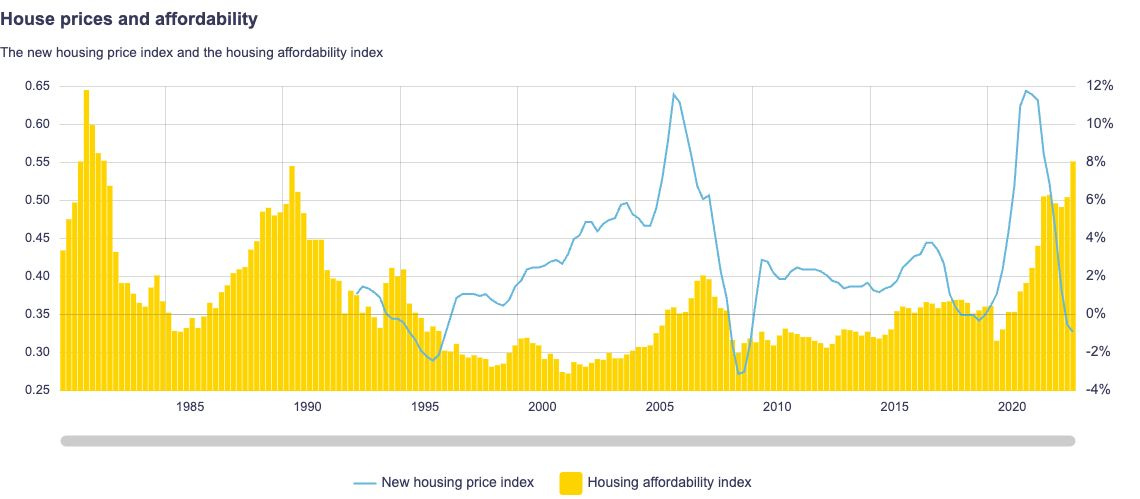Last week, we wove a narrative around the economic forces that are transforming the dream of homeownership into an elusive mirage for many. We delved into the intricate dance between supply and demand, highlighting how governmental inertia has left developers struggling to inject new lifeblood—in the form of inventory—into a market pulsating with unmet desire. The Bank of Canada’s steadfast grip on 5% interest rates, coupled with Deputy Governor Gravelle’s spotlight on Canada’s chronic supply woes, sparked my curiosity: Is this truly the whole story?
In this issue of Property Manual, we embark on an exploratory journey through Canada’s real estate odyssey as it navigated through COVID-19’s turbulent waters. We’ll dissect myths and realities surrounding population growth and its alleged role in fuelling our current affordability crisis.

Behold this chart from none other than BOC itself—a testament to four decades’ worth of housing affordability trends! This index is our compass in understanding how much disposable income families pour into their abodes relative to their overall earnings. A staggering revelation awaits: In fall 2022, more than half—yes over 50%—of household disposable income was devoured by housing costs alone! To find such dizzying heights in historical records one must travel back to 1990 when interest rates soared at over 13%.
The pandemic ushered in an era where central banks worldwide unfurled policies generous enough to make King Midas blush—all aimed at softening economic blows dealt by COVID-19. The Bank of Canada joined this symphony by slashing rates down to seductive lows; little did they know they were setting the stage for a real estate spectacle as buyers swarmed towards tantalizingly cheap mortgages.
As borders reopened post-pandemic lockdowns, immigrants flocked under Maple Leaf flags—with numbers reaching celestial heights: from approximately 184,500 newcomers in 2020 skyrocketing up past record-breaking waves totalling over 431,645 souls just two years later—a clarion call for more roofs under Canadian skies.
Before these unprecedented times struck us like lightning out of clear blue skies—the affordability index hummed along between ranges comfortable enough not to raise alarms (around .35-.36). But then came rock-bottom interest rates beckoning borrowers like sirens luring sailors; suddenly everyone could stretch their borrowing muscles further without breaking a sweat—and thus began bidding wars that would leave many dreams shattered against property price ramparts.
BMO Capital Markets stands tall amidst voices echoing conventional wisdom—they argue that while there is indeed merit in addressing supply constraints head-on—it cannot be done wearing blinders oblivious to monetary policy repercussions.
CUPE too chimes with insights resonant with BMO’s chorus—they sing tales about low borrowing costs inviting not only first-time homebuyers but also investors en masse into markets already bursting at seams; inflating demand balloons until prices soar sky-high beyond reach for average Canadians seeking shelter they can call their own.
Douglas Porter—the maestro Chief Economist at BMO—coined “Revisionism,” painting pictures about reexamining history critically—to challenge established narratives or uncover fresh perspectives across various domains including politics and science alike!
Porter joins me aboard my ship sailing against popular currents—we believe pointing fingers solely towards housing supplies misses marks entirely! Affordability indexes were well within realms deemed affordable right up until year twenty-twenty hit us sideways—and now we see issues magnified manifold due largely thanks ultra-low interests paired alongside significant population surges witnessed within recent five-year spans rather than any longstanding shortage saga!
Even amidst abundant inventories—one finds prices stubbornly refusing soft landings back onto affordable terrains… And so Bank Of Canada unleashed rapid-fire rate hikes hoping perhaps quell investor frenzies squeezing every last drop out affordabilities dry… With lowest points reached during twenty-twenty-one year mark—it seemed investors had eyes glued onto headlines screaming faster populations growing—but who could blame them?
Now let us ponder—who amongst us would willingly take seats offered graciously front row center watching distractions orchestrated masterfully away from true culprits behind these pressing supply issues after all?
Thank you dear readers—for embarking upon another enlightening expedition together—I shall bid adieu till next year arrives bringing forth hopefully sunnier data landscapes…
Wishing you all Merry Christmas & Joyous Holiday Seasons ahead!
Photo by Joseph Chan on Unsplash

